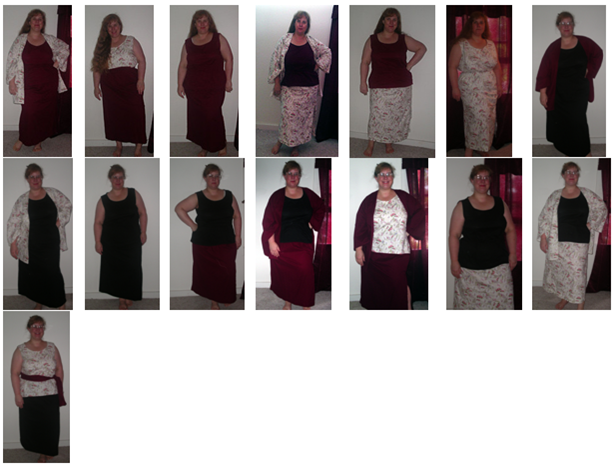I’ve talked before about creating a wardrobe where everything goes with everything else. I did it back in 2008 using the Sewing with a Plan concept, then making sure each time I added a capsule, I added one that went with the rest of the wardrobe. I can go from a barbecue, to hanging out around the house, to an office situation to a party and always look appropriately-dressed. It passed with flying colors just this past week by being more than adequate to handle a cruise. Shell and broomstick skirt, and I was ready to walk in comfy sandals around Nassau or barefoot on the deck. Straight skirt and shell with contrasting scarf with nice flats and understated jewelry and I was dressed nicely for dinner. Pants, shell and jacket and I was ready to fly back to cooler New England.
Oh, and using this concept, you can pack for a week in a carry-on. For the record, I didn’t for the cruise because I deliberately saved room to bring presents back to family. But when I fly, I oh so prefer to carry on luggage!
Thing is, you can do this even if you don’t sew. While in the sewing world it’s often called “Sewing with a Plan” or “Sewing with a Purpose”, in the fashion world, it’s called a “Capsule Wardrobe”. To create one, you kind of have to sit down and think about what it is you regularly do and how you live. I can guarantee you beyond a shadow of a doubt that my wardrobe won’t work for you. We live different lives!
Some Basic Wardrobe Capsule Concepts
Separates are your friends.
You want separates. Yes, even if you like the monochrome look from time to time (I do!) make sure that you’re getting separates. The whole point of a capsule wardrobe is to mix and match.
Pick a color palate and stick to it!
Ideally, you should have two to three basic colors that harmonize and are a bit neutral, then an accent color that goes with at least two of your colors. I break this rule a bit. My colors are burgundy, black, forest green, and deep purple. Obviously the red and purple don’t go so well, but between the black and the print I chose, there’s a lot of anchor between the colors that I don’t mind this minor inconvenience. It’s a pity I don’t like brown or gold, as it would have made a somewhat more harmonious wardrobe.
Minimize Prints.
I would only have one print in my capsule, and this print should go with all the basic colors. This is where the seamstress <Hem! Hem!> has it easy. You buy a print and make a few garments from that. Boom, you’re all good. Shopping makes it a bit more difficult. When I buy ready to wear clothes (one of my sweaters is, as a matter of fact), they’re almost invariably solids.
Keep garments simple.
The design of the garments should be simple. Solid colors, and design details that aren’t too fussy. Are jeans a basic part of your lifestyle? Then my goodness, jeans should definitely be a foundation of your wardrobe capsule! You should have two or three pair that really fit well and flatter – all of them in a single color. You can’t go wrong with basic black, but if black ain’t your thang, just pick another color.
If this is beginning to sound boring? It’s the next step you should be thinking about.
The accent is in the accessories.
There’s a reason French women are so addicted to scarves[1]. I think we’d all agree that French ladies are known for dressing well. They also generally do not have stuffed closets, but minimal pieces chosen with care. Black slacks and a white shirt might make you look like a waiter, but add a fabulous scarf with well-chosen jewelry and you just look elegant. I’m a big fan of scarves myself, just because they’re an inexpensive and versatile way to add color and interest to an outfit.
So, maybe elegant isn’t the look you’re going for. That’s okay. It’s not for everyone. That basic canvas that is your separates can be dressed up or down according to your tastes with lots of funky jewelry, a single small necklace, or choice of hairstyle and bag.
The point of a capsule wardrobe, though, is a plan-ahead thing. Once you’ve created it, you know instantly whether or not something you see in a store will go with your other clothes. You never really have to rush to buy clothes for an event.
What’s in a good capsule wardrobe?
Oddly enough, you don’t necessarily need that many pieces. I have 23 pieces in mine, though you can get by with a lot fewer than that.
At a minimum, you’ll need:
- 4-6 bottoms (Skirts, pants or whatever mixture suits your fancy) in two main colors.
- 3-5 tops in two of your main colors, a contrasting color that suits both of them, and possibly an accent print.
- 1-2 jackets or cardigans that go with all of them.
When choosing tops and bottoms, make sure that a couple of them can be combined to be dressy, even if you don’t usually dress up for much. It’ll keep you from panic shopping for events. For me, this was easy. Black fitted shell, black straight skirt, and voila, I have my Little Black Dress, all ready for my good jewelry and an updo. It’s good for anything but a wedding or a ball, and I own[2] a formal-length dress. (Though in my case, for a wedding, I’d just use a matching shell and skirt in a color appropriate to the season that’s not black).
You might find that you very well already have close to a capsule in your closet already, but only need a piece or two to complete it. If you want to try this out, I’d encourage you to go over your wardrobe, toss what you don’t love and doesn’t fit, but then build your capsule around what you already own and love.
[1] And I blame many of the French teachers at a job I once held for passing this addiction on to me by bringing me back lovely scarves from Paris and Lyon.
[2] Thanks, MOM!



